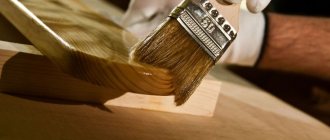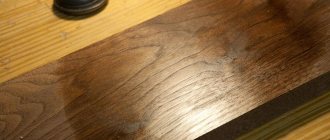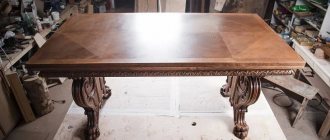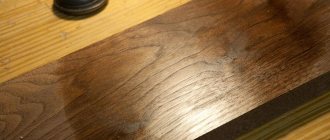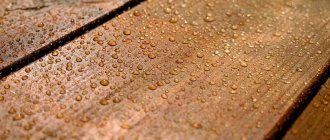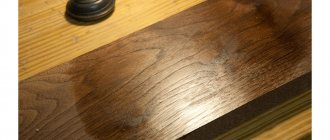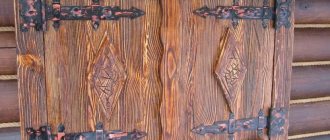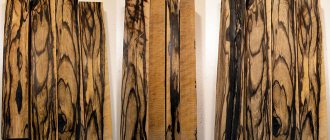The purpose of stain and its difference from paint and varnish
The main purpose of stain is to protect wood from external natural and man-made factors. While maintaining the natural texture, it can give the wood surface almost any color shade.
Moisture protection effect after using colorless stain
The main difference from paints and varnishes is the increased light transmittance, as well as increased moisture resistance. Stains penetrate more deeply into the surface of the wood, forming a protective layer that protects the material from rotting, wood-boring insects, and moisture deformations.
What is stain?
There are so many construction products on store shelves that you can get confused as to what some of them are intended for, for example, wood stain or stain.
The history of the dye goes back to the 19th century. The stain was called “Cologne soil.” Since humus soil, quite loose in composition, was discovered on the territory of Cologne in a non-metic area.
It had amazing properties. If the earth was dissolved in water and applied to a paper or wooden surface, it acquired a rich brown color.
The deposits of “Cologne soil” turned out to be scarce, so they began to develop a substitute for natural stain. Natural dyes today are made from petroleum and coal. Wood contains substances that will allow it to be painted brown without adding chemical components.
The uniqueness of stain is that it does not create a film, as is the case with oil dyes, but reveals the natural pattern on the wood. The surface acquires a rich and contrasting texture. The question of why stain is needed can be answered simply - to give the desired tone to a natural surface.
There is a concept called mordant staining. Some people confuse it with surface application of stain. Of course, there are external similarities, but in the first case the layer is more waterproof.
Summer and spring wood differ in density. Annual rings on spring wood are less colored than on dense summer wood. This contrast can be clearly seen on spruce and pine. Moistened surfaces are obtained with a uniform tone, rather than painting dry.
Wood stain - classification by composition
Depending on the composition, performance characteristics and stain application technology can vary significantly.
Water
The most common and affordable type of stain. Has a wide range of colors. It is produced both in the form of ready-made compositions and in the form of water-soluble powder. In the second case, the color intensity depends on the amount of powder added to the water when preparing the composition.
Advantages : no pungent odor or toxic emissions, recommended for indoor use.
Disadvantages : when applied, it slightly raises the wood fibers, which increases the material’s susceptibility to moisture. Long complete drying time, which is about 12-14 hours.
Various shades of water-based stain
Important! Before applying water-based stain, the work surface must be moistened generously with water. After this, you should pause for 5-10 minutes, then sand thoroughly. Only after this can you begin processing.
Alcohol and nitromordant
It is an alcohol solution of aniline dyes. Denatured alcohol is used as a solvent. It is also produced in the form of a ready-made solution or powder. A distinctive feature is the high drying speed - 20-30 minutes, which is both an advantage and a disadvantage.
To apply nitro stain from alcohol-based compounds, it is recommended to use spray guns
High humidity and careless brushing during application can lead to uneven pigmentation of the treated surface. Therefore, to obtain a uniform color, it is strongly recommended to use vacuum or pneumatic spray guns.
Advantages : quick drying, affordable cost;
Disadvantages : high probability of stains when applied manually, strong and unpleasant odor, toxic emissions (especially nitro stain).
Oily
It is one of the most convenient for manual application. Dissolving different segments in oil gives a wide range of colors and a fade-resistant shade. White spirit is used as a solvent, and technical linseed oil is used as a base.
Applying oil stain using a brush
Advantages : does not form stains, does not lift fibers, provides a high degree of protection of wood from external factors, dries in 2-3 hours;
Disadvantages : unpleasant odor, which disappears after quite a long time after application: from several days to several weeks.
Acrylic
It is produced in the form of aqueous dispersions of acrylic polymers with the addition of pigment. Such compositions have practically no disadvantages, except for their high cost.
Acrylic stain has bright colors
Advantages : dries in 2-3 hours, has no odor, does not emit caustic or toxic fumes during application and during further use, forms a uniform coating without stains, provides reliable protection for wood.
Disadvantages : high price.
Wax
The composition is an aqueous suspension of wax. It has a high density and is applied using fabric. Does not absorb into the material. Forms a relatively thick protective layer on the surface of the wood. It is used as a base “primer” for various paints and varnishes and for polishing products with beeswax.
One-component wax-based stain “Borma wachs”
Advantages : Uniform pigmentation, reliable protection of the base, does not reduce moisture absorption.
Disadvantages : high cost, labor intensive application.
Wax stain application process
Important! Do not use polyurethane or two-component acid-curing varnishes as a topcoat on surfaces treated with wax stain.
Wood stain: neutral colors
Colors in a neutral palette are often used as the basis for creating beautiful interiors. White is an integral part of many modern styles. Modernism, minimalism, Scandinavian style and many other design trends cannot do without this color. The same can be said about black.
White and black are considered the “purest” colors in the palette. Alone, they can fit into almost any style, which is why stains of these shades are widely used by interior decorators. Some people find white too sterile and black too gloomy. For such cases, the optimal solution would be to create contrast. Despite the fact that these shades are complete opposites of each other, their combination is considered classic and never goes out of style.
The most popular stain colors are natural options that harmonize perfectly with the wood.
The neutral color scheme also includes a gray shade, which has its own characteristics and is used under certain conditions.
Helpful advice! In small rooms, it is advisable to use light shades for painting surfaces. Such colors visually expand the space and fill it with light.
Characteristics of stain for white wood
White stain is used to treat furniture made of wood. Interior items made in this color look fresh and very stylish. Such compositions are also used to cover indoor cladding. Sometimes special whitening stains are used for these purposes, which lighten the surface and emphasize the structure of the material. In addition, the coating protects the wood from the negative effects of various factors.
If the item to be coated with stain will be used outside the house, it is advisable to use a composition that has moisture-repellent properties to treat it. For these purposes, you can use white acrylic-based wood stain. In dry rooms, the use of water impregnations is allowed.
Interior items made in white using stain look fresh and very stylish
Using the bleaching procedure, you can restore old wood, which during use has lost its attractive appearance and has become covered with dark bluish spots. A white or lightening composition is suitable for decorating frames on photos and paintings.
The design of white relief products processed with special brushes looks very aesthetically pleasing. This finishing method is called the brushing method. Using hard brushes, soft fibers of the material are removed. The wood is then covered with white stain. After this, you must treat the surface with white, black or gray wax, which will protect it from the harmful influence of external factors.
Features of using black wood stain
Black tinting compounds are used for staining door panels and frames. With their help, you can create a combined design or an interesting decorative effect on a wooden surface.
When choosing a black stain for processing a particular product, it is better to consider options from the category of oil impregnations. Among them you can find products that are suitable even for floors. Oil-based stains are resistant to abrasion. Such coatings can last for a long time without additional restoration. Thanks to these properties, oil compositions can be used to treat floors in high-traffic areas.
Black stain is often used to treat wood floors.
Black stains are used to imitate the color of ebony on the surface of the material. For these purposes, other compositions of dark tones, marked with the appropriate mark, can be used. To achieve this effect, you need to sand the surface of the wood and then polish it. After this, the material is covered with stain. One or two layers are allowed. As a result, the wood will look like a black mirror, with knots appearing on the surface.
Helpful advice! To create the effect of ebony, it is advisable to select hardwoods with a high density of layers and small pores.
In interior photos, the color ebony appears quite often. Such stains are used to treat various surfaces:
- wooden floor coverings;
- furniture designs;
- cladding on the walls in the form of lining or wooden panels.
The effect of ebony stain is achieved through a combination of black, blue, silver and gray shades, as well as other tones close to them.
Black stains are used to imitate the color of ebony on the surface of the material
Aging the surface using gray wood stain
Despite the fact that the gray color of the stain is classified as neutral, it must be used with extreme caution. This shade allows you to give the room an individual appearance. Most often, gray color is used in rooms with light interiors. It goes well with styles such as Provence, antique or Scandinavian.
Against the background of surfaces finished with gray stain, the room looks neat and discreet. On the other hand, this color can bring a certain amount of despondency to it. To prevent the atmosphere in the room from creating a depressive mood for the residents, it is advisable to use a gray shade in combination with bright colors that can create accents in the interior.
Gray wood stain is widely used to create an aged effect. Before starting work, the surface of the material is carefully prepared. It is cleaned of dirt, treated with sandpaper, after which it is necessary to remove the fine dust that is formed during the work process.
How to create an aging effect? To do this you need:
- The prepared surface must be treated with a gray water-based stain. White and other light shades can also be used to age wood.
- The still fresh mixture should be partially removed from the surface immediately after application. This is done with separate strokes in some areas.
- After the impregnation has dried, you need to apply the finishing coat. A composition based on organic solvents is suitable for this.
To stylize wood as antique, you should mix several tones of the mixture
Helpful advice! To fix the shade, the pores need to be filled. To do this, the surface is treated with shellac primer or a varnish composition intended for wood.
There is another technique used to age wood. It involves applying a gray or white stain and then sanding the surface after drying. Then black or other dark-colored wax is rubbed into the material with gentle movements. This will enhance the “age” effect and bring the color of the wood closer to the shade of bleached oak.
Related article:
Wood stains: main types of compositions and subtleties of their useComplete classification of compositions, their characteristics, purpose and application features. Review of the best manufacturers and average prices for stains.
Natural stain colors for wood: a palette of natural shades
Designers are happy to create interiors based on natural materials, so natural shades of stains are in high demand. They harmonize best with wood and emphasize its decorative qualities.
Let's look at the different colors of stains from the natural palette:
- Walnut;
- wenge;
A wide range of colors of modern stains can please even the most fastidious clients
- oak;
- chestnut;
- alder;
- mahogany;
- pine;
- maple;
- nutmeg;
- cherry, etc.
The most optimal options for processing furniture are colors such as walnut and stained oak. The brown range also includes the following shades: chestnut, hazelnut, wenge and nutmeg. If you want to bring a burgundy palette to your interior, cherry, maple and mahogany wood stains are best suited.
Brown wood colors in the interior: bog oak and walnut
Walnut color can be called cozy. It is ideal for interior decoration in the living room, bedroom, as well as in the hallway and corridor. Walnut wood stain can be used to tint absolutely any wooden products and surfaces, with the only exception being the ceiling. This shade is light and noble. At the same time, it emphasizes the texture of the wood in the most advantageous way.
Some of the most popular shades are stained oak, teak and beech.
Bog oak is a special type of material that is obtained as a result of mineralization under natural conditions. This process involves soaking the wood for a long time in water saturated with mineral salts. Under their influence, the shade of the material becomes more saturated and dark, and its structure becomes very durable. It takes several centuries for a tree to reach this state.
Due to its rarity, this material is considered especially valuable, which is why it is very expensive and is processed by hand. However, using an oak stain with a hint of natural moraine, you can create a more affordable imitation. To achieve this effect at home, you need to adhere to a special technology. The first layer of impregnation is applied at a slight angle so that the strokes move across the fibers. When re-painting, the brush should move along them.
Helpful advice! As a tool for applying the composition with the moraine effect, it is better to use a wide flat brush - a flute. It allows you to achieve naturalness and smoothes out transitions thanks to its elastic and soft bristles.
Walnut wood stain can be used to tint any wooden products
This color is suitable for processing various interior elements:
- floor and wall coverings;
- pieces of furniture;
- wooden souvenirs;
- staircase structures;
- doors and windows.
Oak stain with a moraine shade is usually used when creating interiors in classicism and baroque styles. This color is suitable not only for living rooms, but also for commercial and administrative premises.
Tropical wood shades: wenge stain and rosewood
Wenge-colored stain imitates a tropical wood of the same name. This material has interesting decorative characteristics. Wenge has a dark brown color. Its surface is covered with black inclusions and veins.
This shade is suitable for decorating various surfaces in the interior:
- pieces of furniture;
The color of the stain for wenge wood is suitable for interiors designed in a classic style
- door frames and panels;
- window frames;
- accessories;
- floor coverings;
- wooden panels used as cladding.
The noble color of wenge wood stain is suitable for interiors designed in a classic style. This shade brings special charm and attractiveness to the environment, giving the room a respectable appearance.
Rosewood wood stains are also very popular. At one time, this type of tropical wood was so popular that mass deforestation led to the almost complete disappearance of this material. Therefore, stains are an excellent alternative to replace this elite and very scarce wood.
Rosewood is called “rosewood,” although this definition of color is far from the truth. The palette of this material is very diverse. The color of the wood can vary between yellow (from brick to golden) and red-brown (from burgundy to dark chocolate). Sometimes veins of purple and other dark tones may appear against its background.
Rosewood wood stains are in great demand
Burgundy color scheme: photo of wood stains for mahogany and mahogany
Red wood belongs to the category of valuable and elite materials. Therefore, if you want to give the interior a rich and luxurious appearance, it is advisable to use a mahogany-colored stain, in which brown and red shades predominate, to treat wooden products and surfaces.
Like wenge, mahogany color impregnation has a wide range of applications. It is used for processing finishing materials made of wood, as well as furniture. This shade fits harmoniously into the decor of a room decorated in a modern or classic style.
Mahogany stain is a cross between wenge and mahogany colors. In comparison with these shades, such a stain looks much lighter, although it is not able to compete with them in terms of respectability and wealth. On the other hand, this light color will avoid heaviness in the interior. However, don’t get too carried away and overload the room. It is enough to limit yourself to a few accents. This shade is perfect for finishing a wooden dining table.
Important! The color red can have a negative impact on a person's mental state. It is aggressive, so it is not recommended to use this shade for decorating a bedroom interior.
A bright and rich burgundy palette is represented by shades of mahogany, red cherry and maple
Atypical colors of wood impregnations: exotic design
Natural impregnations are preferred by people who have a traditional view of the appearance of wood. But this does not mean that exotic design options are not in demand among consumers. Modern color stains for wood can give the material an unusual and bright shade.
The most popular color options:
- green spruce and fern - a stain of this shade is simply created for treating furniture in a children's room;
- Oregon - used to tint wood dark red, the result is rich and deep;
- mocha – gives the surface the color of freshly brewed coffee;
- lemon - stain has a beautiful yellow tint and is used to enhance the tone by applying it in two layers.
Green shades in the interior have a relaxing effect. After a busy day, this environment helps to relax the eyes. For this reason, green stain is ideal for treating wooden surfaces in a child's room, bedroom and living room.
To create unusual effects on wood, not only classic wood shades are used, but also brighter ones
Despite the fact that cold-colored stains are very rarely used in interiors, you can find many compositions on sale that can give the surface a blue or blue tint. Mostly such solutions are used to treat children's and sometimes kitchen furniture. The appearance of a room in which blue is present in the interior becomes expressive, but only if optimal combinations are created. This shade looks good in tandem with white or yellow.
Consumption
The stain is well absorbed into the wood. In addition, when purchasing the required amount of finishing material, it is necessary to take into account the porosity of the base. As a rule, 1 liter of ready-made solution is enough to treat 12-15 m². However, the method of application and the type of building structures should be taken into account. For example, when applying stain from a spray gun, the diameter of the nozzle and pressure are of great importance. The optimal option for aqueous solutions is 1.5 mm at a pressure of 3 atm, and for alcohol and nitromortars - 1.3 mm at a pressure of 2-2.5 atm. The stain should only wet the surface being treated and not sit there in puddles.
Penetration of stain into the wood structure
How to make it yourself
You can prepare a simple stain for wood processing at home:
- from plant ingredients;
- from tea and coffee products;
- from chemical components.
Based on plant materials
- Decoction of onion peels to obtain a bright red hue.
- A decoction of walnut peels to obtain a rich brown hue. To do this, the shell is crushed to a powder and boiled for 12 minutes in water. Add 1 tsp to the finished strained broth soda _ To obtain a red tint, potassium bichromate is added instead of soda; for a gray color, vinegar essence is added.
- Decoctions of oak, willow and alder bark give a rich black color.
- A decoction of buckthorn berries will paint the wood an attractive golden color.
From coffee, tea and vinegar essence
- To get a rich brown tint, it is enough to combine natural ground coffee and soda .
- To stain light wood, you can use a strong brew of black tea .
- To obtain a deep black shade, you need to place metal nails in a container and fill them with acetic acid . Leave for 5-7 days in a dark place.
Based on chemical components
- The brown tint is obtained after treating the wood with a solution of slaked lime .
- A deep cherry tint is achieved by applying a solution of potassium permanganate . To do this, you will need 60 g of potassium permanganate, which is diluted with a liter of heated water.
- A rich yellow tint is obtained by treating the surface with a decoction of barberry roots , to which alum is added.
- The herbal color will be obtained by combining 60 g of verdigris and vinegar essence . The mixture is boiled for 10 minutes.
- The dark brown color is obtained by combining wolfberry with copper sulfate . Glauber's salt with these berries gives a red color, and soda gives a blue tint.
With whitening effect
Bleaching stains are used as a base before painting wood, allowing you to achieve unusual color solutions . For example, apple wood can acquire a noble milky hue, and walnut can acquire a red or light pink color.
Whitening stains can be prepared as follows:
- Composition based on oxalic acid. To do this, 6 g of acid is diluted with 120 g of warm water. The finished stain is suitable for processing light or bleached wood. After application, the surface is thoroughly washed with the following solution: 4 g of soda and 16 g of lime are diluted in 110 g of water.
- Hydrogen peroxide based solution. To do this, you will need a 30% peroxide solution, which is available for sale at any pharmacy. It is suitable for bleaching various types of wood. However, it should not be used on oak, rosewood or mahogany.
Color palette
The stain is absorbed into the outer layer of the wood surface. It colors the material non-uniformly, depending on the density of the fibers. Thanks to this, the natural texture of the wood is completely preserved. If previously wood stain could only be used to darken wood, now various compositions make it possible not only to lighten wood, but also to convey various, including rich, shades to it. Color saturation depends on the following factors:
- species and original shade of wood;
- porosity;
- density;
- textures.
In terms of color palette, modern stains practically do not differ from high-quality paints
The same composition can color different types of wood differently. For example, after treatment with nitro stain, oak will become dark brown, and maple will become yellowish. It should be taken into account that coniferous species absorb stains less well and unevenly. Therefore, before processing, it is necessary to carefully remove the resin from the surface and coat the product in two layers.
Briefly about the main thing
Initially, the term “stained” was applied to oak wood that had lain in water for a long time, as a result of which it became darker. Due to similar results, this is now the name given to the treatment of any wood with special compounds called “stain” or “stain”.
Compared to paints and enamels, stains not only paint, but also highlight the natural texture of wooden surfaces, creating the same staining effect. Thanks to stain treatment, even ordinary wood can be “disguised” as oak or other valuable wood.
In fact, changing the shade is the main purpose of wood stains. But depending on the composition, they can also have wood-protective properties. Such coatings are more expensive, so they are used much less frequently.
Based on the type of base, all stains can be classified into water based - they are the most common and accessible, alcohol, wax - relatively new and oil based. Each of these types has its own advantages and disadvantages.
In most cases, to improve the characteristics of the coating, a layer of transparent varnish is applied after tinting.
Ratings 0
Manufacturers
Stains are produced by the same companies that produce paints and varnishes. Among the most well-known manufacturers whose products enjoy deserved popularity are the following:
- Germany: Flamingo, Dufa, Caparol;
- Türkiye: Betek, Dyo, Marshal;
- Slovenia (Belinka Belles) - Belinka trademark;
- Finland - Tikkurila;
- France - Liberton;
- KANSAI PAINT group – international trademark Helios;
- AkzoNobel international corporation - DULUX trademark.
Reviews
Feedback on the use of Dufa Wood Protect decorative stain for exterior use:
More details on Otzovik: https://otzovik.com/review_6882914.html
Dufa Wood Protect stain
Review of the whitening effect of Lazur Belinka impregnation for wooden surfaces:
More details on Otzovik: https://otzovik.com/review_3319816.html
Stain Lazur Belinka
Review of the use of Tikkurila “Pirtti” stain:
More details on Otzovik: https://otzovik.com/review_2976068.html
Tikkurila Pirtti stain
Review of Liberon Black Bison wood wax:
More details on Otzovik: https://otzovik.com/review_6460180.html
Liberon Black Bison stain
Review of Dulux Woodshen water-based varnish-stain:
More details on Otzovik: https://otzovik.com/review_1957367.html
Dulux Woodshen stain
Types of oil-based stains
There are two types of oil stains: impregnating and pigment.
Pigment compositions are applied to the surface of a wooden product with clean, soft swabs made of fabric. After a certain time, it should be erased. It is not necessary to withstand the stain for any specific time; you should proceed from how rich the shade of wood is needed. The longer you hold it, the darker the material will become. However, it is recommended to remove the stain a little earlier than the desired effect is achieved, since the part of it that has penetrated the wood fibers may darken for some time. The disadvantage of this treatment is that it is less resistant to direct sunlight and if the wood is not covered with a sealant after it, it will quickly fade.
Impregnating oil stain for wood is more difficult to apply, so it is not recommended for beginners. Insufficient application skill may result in the formation of colored streaks and spots.
Each type of oil stain for wood has its own advantages and disadvantages, which become less noticeable with experience, since the result of the treatment directly depends on the skill of the processor.
Features of choice
First of all, it is necessary to select the composition of the stain based on the area of use. They, like other paints and varnishes, are divided into two main groups: internal and external.
Manufacturers provide a wide range of stains with different performance characteristics and color options.
Each type of wood has a different structure, which determines the possibility of painting it. You should not try to stain coniferous wood with an intense color using stain. You can get spots of different pigmentation on the surface. It is advisable to lightly tint coniferous species. On the contrary, hardwoods absorb moisture well. Consequently, a wide variety of coloring compositions can be used.
Video: Rules for choosing stain for interior work
What is stain used for?
In a professional environment, stain for woodworking is called “stain.” This liquid product allows you to give the desired color to wood without changing its texture or pattern. On the contrary, stains emphasize the entire aesthetics of natural wood, enhancing it, and ennoble simple species: after processing, even pine can be “made” into dark oak or other expensive types of material.
Any wooden products, despite their strength, are susceptible to various adverse factors. Using stain, you can protect wood from damage by putrefactive fungi. There are different types of stains, the properties of which depend on the composition.
The main qualities of fighters:
- protection of wood from ultraviolet radiation;
- extermination of wood borers and other pests;
- increasing surface service life;
- wood lightening;
- moisture-proof function;
- possibility of restoration of old products;
- compaction of the material structure;
- preparing wood for further processing - painting, varnishing.
Some stains should be used only indoors - for covering floors, countertops, furniture, interior doors. Others are suitable for outdoor work - for example, for treating the floor on an open veranda. Some products are used only on the surface layers of wood, others are characterized by the possibility of deep penetration. Many modern stains can not only be applied to the base, but also perform various interesting effects - combining tones, creating shades uncharacteristic of wood.
The difference between stain and drying oil, paint, varnish
Stain is a means of adding texture to wood. It penetrates deep into the wood, tinting it from the inside without closing its natural pores and preserving the pattern, while protecting it from rotting and destruction. Drying oil also protects the material from moisture and putrefactive processes, but after its application a film appears on the surface.
Drying oil weakly penetrates into the deep pores of wood, but clogs them from the outside. While stain can become an independent finishing product, drying oil is used only to prepare wood for further work to improve the quality of staining and reduce the amount of paint.
Varnish is also very different from stain impregnation. Varnish is a film-forming agent, and the protective film from it is formed after the solvent evaporates from the surface. Oil varnishes form a super-strong elastic film that is not easy to wipe off even with white spirit. Again, the varnish layer will have to be renewed over time, first removing the previous one. Usually varnishes are used where there is a strong influence of atmospheric factors, and stain will have to be applied too often.
Paint is another popular material for finishing wood. You can paint absolutely any wood product: from floors to window sills or furniture. After painting, a dense, opaque film is formed on the surface, which will completely hide the natural wood grain - this is a fundamental difference from stain. Typically, the color range of paints is far from natural: white, black, brown, and green paints and varnishes are most often sold. After 2-3 years, many types of paints lose their strength, peel off, after which you will have to completely remove the old layer and apply a new one.
Application technologies
There are four main methods of applying stain.
Rubbing - recommended when processing porous wood. Significantly reduces consumption, allows for uniform pigmentation, and shows the wood texture well. The stain is applied to the surface of the base and distributed over the entire area using fabric swabs. Recommended for oil and wax compositions.
Applying stain using a special cloth swab
Application by roller - a medium-density foam roller without relief is used. Prevents the formation of streaks and allows the composition to be more evenly distributed over the entire surface. Recommended for oil stains.
Applying nitro stain with a roller
Spraying - both vacuum and pneumatic spray guns and sprayers can be used. The flow rate depends on the operating pressure and nozzle diameter. Recommended for alcohol and nitro stains.
Spray application is used to quickly cover large areas.
Processing with a paint brush allows you to get a rich color. As a rule, it is produced in two or three layers. Suitable for acrylic and water stains.
Traditional brushing is done along the direction of the wood grain
Stages of the stain application process:
- It is necessary to carefully prepare the surface of the base: remove old paintwork, dust and dirt. It is advisable to degrease the surface. When processing coniferous wood, it is imperative to remove the resin using a weak solution of white spirit.
- The first layer should be applied exclusively in the direction of the wood grain.
- If the base is treated with stain in several layers, then each subsequent layer is applied crosswise to the previous one.
- For the first layer, you can use diluted stain (no more than 10-15% of the total volume).
- After the first layer has dried, it is recommended to sand it to eliminate raised lint and increase adhesion between layers. For this, sandpaper from No. 180 to 400 is used.
Color spectrum
Beitz is a unique product that helps give wood a noble shade. The structure of the wood is heterogeneous, different areas are impregnated unevenly, therefore, after the composition dries, an original pattern is created on the surface. The most popular shades of stains are included in the wood range; their names correspond to different types of wood. There are also other types of stains on sale: green, black, red, blue and corresponding to other tones that are usually used for painting furniture. If you can’t choose the right color, stains of the same type and brand can be mixed together.
When purchasing, you should carefully consider the samples on which the stains are applied, because the shade on the label and in reality may not match. The finished color will depend on the following factors:
- original wood shade;
- degree of porosity of the material;
- density;
- breed;
- amount of resin.
Deciduous wood is impregnated much better than coniferous wood, so the tone will be as close as possible to the stated one. To give a light shade, you can purchase a lightening impregnation, which also tends to emphasize the wood grain. There are even colorless stains on sale that do not change the color of the wood, but still have full protective properties.
Correcting possible errors
Unlike paint, defects resulting from wood stain treatment are extremely difficult to remove. Therefore, when applying, it is necessary to carefully follow the work procedure and be extremely careful:
- if grout has formed as a result of applying stain, it is necessary to remove it as quickly as possible using a dry cloth;
- if the applied finish has already set, but has not yet completely dried, then a second layer is applied to the treated surface, and then both are removed with a piece of cloth;
- if the stain is completely dry, then you will have to use a solvent in combination with abrasive sandpaper;
- When using a highly pigmented stain, the only solution is to remove the outer layer using a plane.
Video: correcting stain defects
General characteristics of ProArt stains:
- All ProArt stains are concentrates that can and should be diluted to the desired saturation. When using concentrates in their pure form, the result is a strong, extremely dark or saturated color from one coat of coating.
- Subject to storage rules, the shelf life of stains is unlimited.
- Before use, be sure to thoroughly mix the stain to achieve uniformity of the material.
- All stain colors of one base mix perfectly with each other to obtain the desired color and shade.
ArtBlank.
DIY stain
You can give wood a different shade and at the same time protect it from external influences using “folk” remedies.
Herbal Ingredients
- rich decoction of larch bark or onion peel - red tint;
- a decoction of walnut shells or a mixture of willow bark, oak, crushed walnut shells and alder catkins in equal proportions - brown;
- oak and alder bark in equal proportions - rich black color;
- a decoction of unripe buckthorn fruits - a golden yellow hue on light wood and deciduous wood;
- It is advisable to mix all of the listed decoctions with oil stains or, after tinting the wood, treat it with protective impregnations.
Painting wood with onion peels
Using a decoction of alder and oak bark for tinting
"Household" materials and substances
To create a stain, you can use materials and substances that are quite common in everyday life:
- ground coffee with baking soda in equal proportions - create different shades of brown, depending on the intensity of dilution with water;
- tea in varying concentrations tints light wood with a brown tint;
- To create the effect of ebony, the surface must be treated with an “infusion” of acetic acid. To do this, small iron nails are filled with acetic acid and left for 3-7 days without light.
Ebony effect, the result of treating wood with an infusion of acetic acid
Staining wood with coffee
Chemical stains
- After treatment with slaked lime, oak acquires a brown color, walnut - a brownish-olive tint.
- Olive color can be given to any wood veneer by treating it with hot verdigris powder in vinegar. Take 50-60 g of powder per 0.5 liter of 9% table vinegar, boil for 10 minutes, treat the wood with a hot solution.
Bleaching oak with slaked lime
Tips for choosing
When choosing the composition and color of the stain, it is necessary to take into account that when applying the same product to different types of wood, each time there will be a new shade. Tips for choosing impregnation:
- Porous and soft woods absorb stain well: hardwoods are deeply and quickly soaked; conifers cannot be changed, but only given a slight tint.
- Dark wood will become even darker after staining. Popular stains include beech, teak, oak and cherry.
- The natural beauty of the board will be emphasized by colorless stain.
- For whitening external surfaces, white wax stain or alkyd-based compositions are suitable.
- The consistency of the composition affects the intensity of the shade. A mixture that is too thick will make it difficult to apply, but will give a richer color. Liquid stains will not provide the desired depth of shade and must be applied in several layers, but in this case the wood will be painted evenly.
- Pigment stains fill the ribs and reliefs of the wood, leaving the rest of its surface less painted.
- For structures with cracks and irregularities, it is necessary to choose special priming compositions with a porosity filler.
- Alcohol compositions are convenient for treating furniture and doors; stains may form when painting stairs and parquet. Stain looks beautiful on walnut and mahogany pieces. Stained paint is not suitable for elements made of spruce, poplar, cherry, birch and pine. To reduce the appearance of possible defects, the top of the object is processed first.
You need to select the stain on a sample of the board that is to be processed. Otherwise, you may get the wrong result.
How to choose wood stain: varieties and application
Wood is one of the most beautiful materials known to man. Using various methods of finishing it, you can achieve the most vivid expression of this beauty, and today we want to talk about the most effective method - using stain. You will learn which stain to choose for wood, and what features are typical for its different types.
American wood stain allows you to tint various parts of your home.
Compound
The composition of oil stain for wood includes:
- solvent;
- drying oils or oils;
- color (dye).
The basis of each composition is drying oil or oil. White spirit is most often used as a solvent, since its effectiveness has been proven by many years of practice. And the color of the stain is selected based on what color needs to be obtained subsequently.
The article presents the process of working with oil stain on wood (pictured).
Application rules
Oil stain for wood is best applied with a brush or roller. During the processing process, you should never skimp on the product, as this will lead to uneven coloring with stripes or spots. During the painting process, you may feel that the shade of the wood will end up darker than necessary. This will not happen if, a couple of hours after application, the solution that has not been absorbed into the surface is thoroughly wiped off. And in cases where the wood, after drying, turns out to be lighter than expected, you can paint the surface again. In fact, the drying speed also depends on the concentration of the stain itself; if it is more concentrated and thick, then it will take longer to dry.
Oil-based wood stain dries within a few days. Whether it dries quickly or not directly depends on the temperature at which the treated surface is located.
In order to avoid stains appearing on the material after the stain has dried, you should carefully prepare it for painting, carry out the painting itself in good faith and spend as much time on it as necessary, without missing any nuances.
Strict adherence to all these recommendations will allow not only a professional, but also a beginner to stain wood efficiently even at home.
